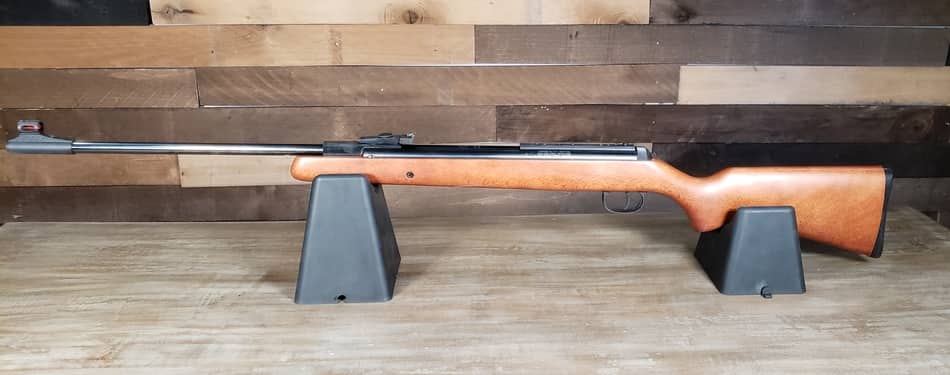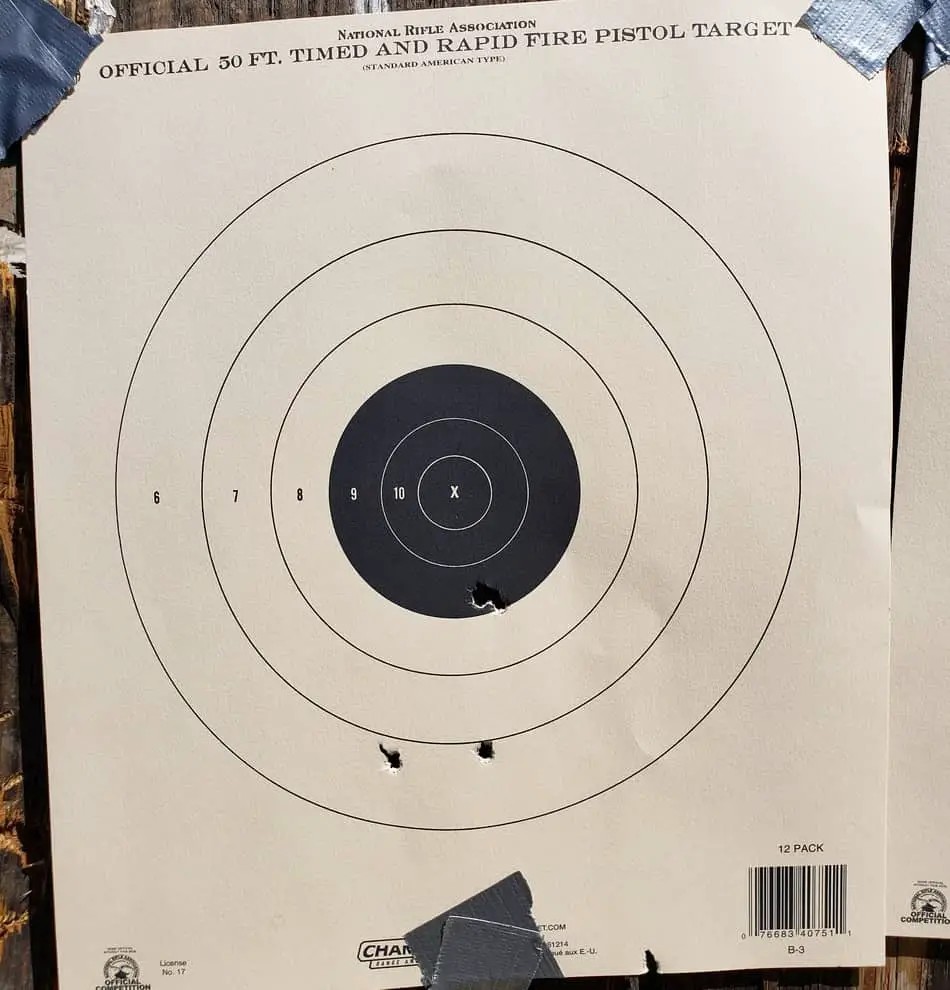
We’ve been doing quite a few reviews, and found them to be really enjoyable, so up next: the Diana RWS 34 Breakbarrel. What’s good about this gun, what’s bad about this gun, and what can make it work better?
Overall, the Diana RWS 34 is a good quality airgun. It has a solid build with a nice trigger, but also has a few issues with the open sights. It is an accurate gun with a good power output, but is overpriced.
Would I Recommend this Gun?
I would be hesitant to recommend this gun. I don’t think that it is a bad gun at all, in fact, I do enjoy shooting it, but with the price that the gun comes at, I would expect more from the gun than what you currently get.
See, we bought our copy for $300, its available at Pyramyd Air for $280. That’s pretty expensive for a springer, so I would expect the gun that I get to be a bit better at being an expensive gun. Again, I don’t think that this gun is a bad gun per say, but I do think that it is a bit overpriced.
for $280. That’s pretty expensive for a springer, so I would expect the gun that I get to be a bit better at being an expensive gun. Again, I don’t think that this gun is a bad gun per say, but I do think that it is a bit overpriced.
See, there isn’t anything really special about this gun other than its solid build quality. It works great at being solid, but otherwise it has nothing too special about it. In fact, the cocking action is kind of really stiff.
As far as accuracy, we saw pretty much average performance for an airgun, making us unsure of whether or not this gun was worth the price tag.
Overall, the gun is a good gun, and if the price tag were to drop closer to $230 or below, I would recommend this gun, but as it stands now, I believe that you can get more airgun for less money by looking elsewhere.
Core Features

Starting at the front of the gun, we see plainly that the RWS 34 comes with a set of open sights, a handy feature for being able to use the gun right out of the box, but one that actually works kind of backwards. See, the front sight has a ring around it, which isn’t a bad thing except for the fact that the ring obscures the target, making accurate shooting with the open sights kind of really hard.
This problem is amplified by the fact that the stock is not shaped well enough for use with open sights; put simply, it ain’t comfy, and I mildly dislike when things ain’t comfy.
This isn’t a huge problem, but it is definitely a thing to be aware of. This was pointed out to me by my friend Brad, who you may have seen on the YouTube channel. When we were shooting prone, the stock was shaped in just the right way that we couldn’t lower our faces enough to look comfortably through the open sights.
If you were to use a scope, I doubt that you would experience this issue, but we wanted to shoot this gun as it came to us. So all in all, don’t use the open sights unless you have to; they are not effective and not comfortable.
Up next is our standard dovetail rail– except wait! This isn’t a standard dovetail rail at all. If you were to get a good look at it, you’d see that a lot of thought and energy went into this rail, much more than most airgun rails get.
That, combined with the fact that the open sights are not exactly the greatest suggest to me that this gun was intended for use with a scope. Maybe if you add a good quality scope, you’ll get more enjoyment out of this gun than we did.
The cocking action of this gun is also something that we wish had been engineered a little better. Why? Well, its stiff. Really stiff, like super stiff, which surprised each of us as we took turns shooting it, as most other springer airguns are a lot lighter than that.
This extra stiffness is not because you are compressing a higher quality spring, and therefore giving you more power than other airguns would, as we get about 680 feet per second with a .22 caliber 14.44 grain pellet, which pretty much matches the other .22 caliber springers we have while shooting the same pellet.
So the cocking action is unnecessarily stiff, but what about the other features of the gun?
I already talked about the stock, but I didn’t mention how it is made of nice beech wood, which does lend to the gun’s cosmetics and feel of being solid.
The butt plate however is not as nice as some of the other airguns that I have seen. See, when the trigger is pulled, the spring in the gun jumps forward, which pushes the gun backwards into your shoulder. When the spring suddenly is stopped, the gun jumps forward, out of your shoulder.
So even though you may not think it, springer airguns have a fair bit of recoil, enough to give scope burn. Without a rubber butt pad, the recoil isn’t terrible, but it is nice to have somethings softer than solid plastic jumping into your shoulder.
Small things like this continue to make me think that this gun is not worth the extra money that you would pay in order to acquire this gun.
The trigger is a really nice piece though. I would say that this is one of the best features of the gun. It’s light and smooth, does the job well, and allows you to stay on target well. I have only good things to say about the trigger, which is amplified by the fact that it is adjustable. So if you don’t like the weight of the trigger, you can change that to suit your tastes.
I do have issue with the safety. The safety sits at the top of the receiver, right where your thumb sits, which makes it easy to access and easy to use. That’s just fine, I like that about the safety. Additionally, when you cock the gun, the safety comes on, which I think is another good feature of the gun. My issue lies in the fact that cocking the gun is the only way to turn the safety on.
See, when you cock the gun, the safety comes on. When you turn the safety off, you cannot turn it back on without firing and then cocking the gun again. You cannot pull it back to safe. This is of course a problem. I can easily see a situation in which someone acquires a target, turns the safety off, and then for really any reason, decides not to shoot.
In that situation, the only way to make the gun safe again is to fire your shot, which you have already decided is not a good idea.
Now, manufacturers of airguns discourage folks from leaving their springs compressed for too long, or else the spring loses some of its… springiness. Most of them say about an hour is too long for a spring to be compressed. Maybe they implemented this aspect of the safety in order to discourage people from keeping their springs compressed for too long, I don’t know.
What I do know is that the safety could be better.
This gun has a standard mainspring– no fancy gas rams. That is not a bad thing, it just means that you will have to watch out for how long you keep your spring compressed (again, manufacturers claim no longer than an hour), be mindful of the extra recoil, and remember that cold weather probably will affect the performance of this gun.
Performance

Okay, so now its time to talk about how this gun shoots, and I will say it does pretty well in actual performance, which may surprise you, as I have not been exactly positive when talking about this gun.
Now, the accuracy of this gun was good if you take into account that we were shooting with open sights. At 25 yards with the right pellet, I was able to get three shots into almost the same hole, with two outliers that were really far off.
Again, I can reasonably blame the fact that I was shooting open sighted, with a sight that obscured my target quite a bit. So, if you had a scope, it would probably work really well for you.
With the 14.44 grain pellets that I was shooting, our chronograph read a muzzle velocity of 681 feet per second, average for a .22 caliber springer. That’s actually a pretty good speed, when you conisder the fact that if you go too fast, your pellet loses accuracy. In fact, Olympic level shooters prefer to stay just under that that speed.
681 feet per second with a 14.44 grain pellet comes out to be almost 15 foot pounds of energy, which is more than enough to handle pretty much any small game and pests that you might need to.
There is a .177 caliber version of this gun, we have the .22 caliber version, which means that ours would be better suited for killing those small game and pests.
Do keep in mind the fact that when you pull the trigger, the gun will sound out at 115 decibels, which is about the same sound level as a leaf blower. That’s not quiet, in fact, The RWS 34 is tied for the loudest airgun we have at Airgun Ace.
Things I Like
Overall, I think the gun is build sturdy. I mentioned the beech wood stock, and I really enjoy the look that that gives the gun. Additionally, the cosmetics of the gunmetal barrel look great.
I appreciate that the scope rail received so much attention, though I am not entirely sure what all of the workings add to the overall quality of the gun.
Again, the trigger is nice, and I love that about the gun.
Things I Would Have Changed
Okay, I spent quite a bit of time already talking about what I would have changed about the gun and why, so I’ll just give a quick run down of what I talked over already.
- Safety
- Needs to be able to turn back on without cocking the gun again.
- Buttpad
- Just add a thin rubber layer to ease up the recoil.
- Easier Cocking Action
- Make it less stiff and easier to use.
- Remove the Ring Around the Front Sight
- This would just make it easier to acquire your target without obscuring it.
